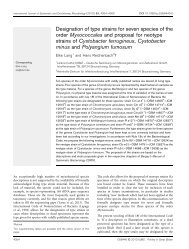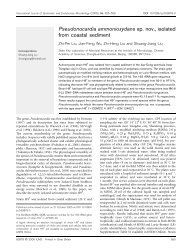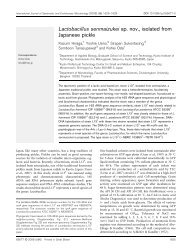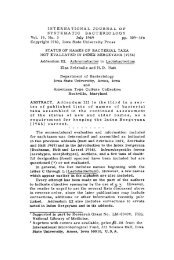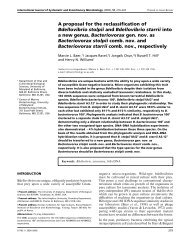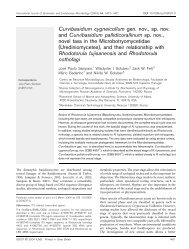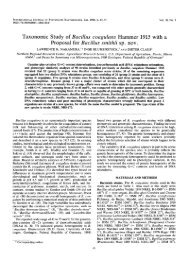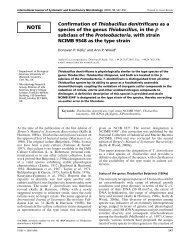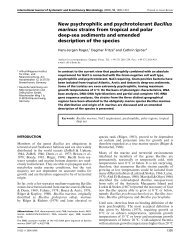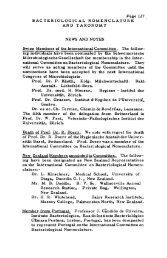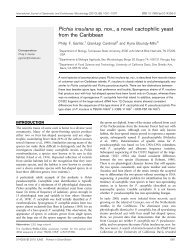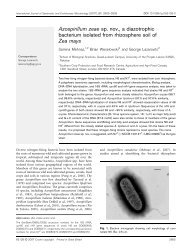Stenotrophomonas acidaminiphila sp. nov., a strictly aerobic ...
Stenotrophomonas acidaminiphila sp. nov., a strictly aerobic ...
Stenotrophomonas acidaminiphila sp. nov., a strictly aerobic ...
Create successful ePaper yourself
Turn your PDF publications into a flip-book with our unique Google optimized e-Paper software.
E. A. Assih and others<br />
Table 2. Action of antibiotics towards strain AMX 19 T<br />
.................................................................................................................................................<br />
Sensitivity: , sensitive; , not sensitive; , intermediate<br />
sensitivity. For the amoxicillinclavulanic acid test, the disk<br />
charge with the two compounds was 20 and 10 µg. For the<br />
piperacillintazobactam test, it was 75 and 10 µg. MIC eq ,<br />
Equivalent minimum inhibitory concentration according to<br />
the Comite de l’antibiogramme de la Socie te Franc aise de<br />
Microbiologie (1997). The reported MIC eq for piperacillin<br />
and piperacillintazobactam corre<strong>sp</strong>ond to those<br />
recommended for Pseudomonas aeruginosa.<br />
Antibiotic Sensitivity MIC eq<br />
(mg l− 1 )<br />
Aminoglycosides (inhibition of protein synthesis)<br />
Amikacin (30 µg) 8<br />
Gentamicin (10 UI) 4<br />
Netilmicin (30 µg) 4<br />
Tobramycin (10 µg) 4<br />
Fluoroquinolones (inhibition of nucleic acid synthesis)<br />
Ciprofloxacin (5 µg) 1<br />
Ofloxacin (5 µg) 1<br />
Polypeptides (disruption of cell membranes)<br />
Colistin (300 UI) 2<br />
Sulfonamidesdiaminopyrimidines (inhibition of folate<br />
synthesis)<br />
Trimethoprimsulfamethoxazole 238<br />
(1252375 µg)<br />
Carbapenems (inhibition of peptidoglycan synthesis)<br />
Imipenem (10 µg) 8<br />
Cephems (inhibition of peptidoglycan synthesis)<br />
Cefalotin (30 µg) 32<br />
Cefotaxime (30 µg) 32<br />
Ceftazidime (30 µg) 4<br />
Penicillins (inhibition of peptidoglycan synthesis)<br />
Amoxicillin (25 µg) 16<br />
Amoxicillinclavulanic acid 16<br />
Piperacillin (75 µg) 16<br />
Piperacillintazobactam 16<br />
Ticarcillin (75 µg) 16–64<br />
rather low binding values compared with the <strong>sp</strong>ectrophotometric<br />
method (Hauben et al., 1999).<br />
DISCUSSION<br />
Identification<br />
Strains AMX 17 and AMX 19T exhibited very high<br />
similarity in their CFA profiles and identical partial<br />
16S rRNA sequences (500 bp); we therefore assumed<br />
that they belong to the same <strong>sp</strong>ecies, and strain AMX<br />
19T was chosen arbitrarily as the type strain. The<br />
phylogenetic analysis disclosed without doubt that<br />
strain AMX 19T is affiliated to the family Xanthomonadaceae<br />
of the γ-subclass of the Proteobacteria<br />
and, within this family, to the genera <strong>Stenotrophomonas</strong><br />
and Xanthomonas. This is in agreement with its<br />
CFA profile and GC content and the fact that it is a<br />
<strong>strictly</strong> <strong>aerobic</strong>, Gram-negative, non-<strong>sp</strong>orulating, motile,<br />
straight to curved, rod-shaped bacteria (Palleroni<br />
& Bradbury, 1993; Vauterin et al., 1995). Other<br />
phenotypic traits, such as testing positive for oxidase,<br />
the presence of a nitrate reductase and an optimum<br />
growth temperature over 30 C indicate that strain<br />
AMX 19T cannot be a member of Xanthomonas and<br />
that it is more likely to be a member of <strong>Stenotrophomonas</strong>,<br />
de<strong>sp</strong>ite its monotrichous flagellation. In<br />
accordance with these phenotypic characters, analysis<br />
of the 16S rRNA sequence of strain AMX 19T revealed<br />
that the known <strong>Stenotrophomonas</strong> <strong>sp</strong>ecies were its<br />
closest relatives together with P. pictorum ATCC<br />
23328T (Fig. 2). As strain AMX 19T shares only 967<br />
and 964% sequence similarity with S. maltophilia<br />
LMG 958T and S. africana CIP 104854T, it cannot be<br />
a member of either of these <strong>sp</strong>ecies (Stackebrandt &<br />
Goebel, 1994). The DNA–DNA hybridization values<br />
of strain AMX 19T with S. maltophilia CIP 60.77T<br />
(31%) and S. africana CIP 104854T (267%), which<br />
were significantly below the 70% proposed by Wayne<br />
et al. (1987), corroborate this result. It is interesting to<br />
note that, in contrast to S. africana CIP 104854T and S.<br />
maltophilia LMG 958T or LMG 11114, strain AMX<br />
19T was never identified as S. maltophilia by the MIDI<br />
fatty acid identification system or upon use of classical<br />
biochemical identification kits such as API 20 NE<br />
strips (Drancourt et al., 1997; Hauben et al., 1999; this<br />
study). This attests to the fact that AMX 19T is<br />
phenotypically distinct from these <strong>sp</strong>ecies and that it<br />
can be distinguished from them easily by simple,<br />
commonly available identification tools. The 16S<br />
rRNA phylogenetic analysis did not, however, allow<br />
us to discriminate strain AMX 19T at the <strong>sp</strong>ecies level<br />
from P. pictorum ATCC 23328T (9801% similarity) or<br />
S. nitritireducens DSM 12575T (986% similarity). The<br />
DNA–DNA reassociation experiments performed to<br />
resolve the phylogenetic relationship of these bacteria<br />
demonstrated without ambiguity that AMX 19T cannot<br />
be affiliated to P. pictorum (hybridization of only<br />
436%). This is consistent with the fact that, in the<br />
dendrogram constructed from the CFA patterns, P.<br />
pictorum linked with strain AMX 19T at a Euclidian<br />
distance of more than 15, which is much higher than<br />
the usual cut-off limit between <strong>sp</strong>ecies (Fig. 1). The<br />
genomic information obtained during this study,<br />
combined with comparative phenotypic analysis done<br />
by others (Van den Mooter & Swings, 1990; Oyaizu &<br />
Komagata, 1983), suggests that P. pictorum should be<br />
affiliated to the genus <strong>Stenotrophomonas</strong>. A DNA–<br />
DNA hybridization value below 70% was also observed<br />
between S. nitritireducens DSM 12575T and<br />
AMX 19T. Since this value (658%) is close to 70%,<br />
one could argue that this is not sufficient to separate<br />
the two strains in different <strong>sp</strong>ecies, particularly when<br />
one considers that the type <strong>sp</strong>ecies of <strong>Stenotrophomonas</strong><br />
(S. maltophilia), while phenotypically very<br />
homogeneous, appears to be characterized by significant<br />
genomic diversity (16S rRNA similarity from 916<br />
to 997%, DNA–DNA hybridization from 5 to 95%;<br />
Hauben et al., 1999). Nevertheless, in the case of AMX<br />
564 International Journal of Systematic and Evolutionary Microbiology 52



